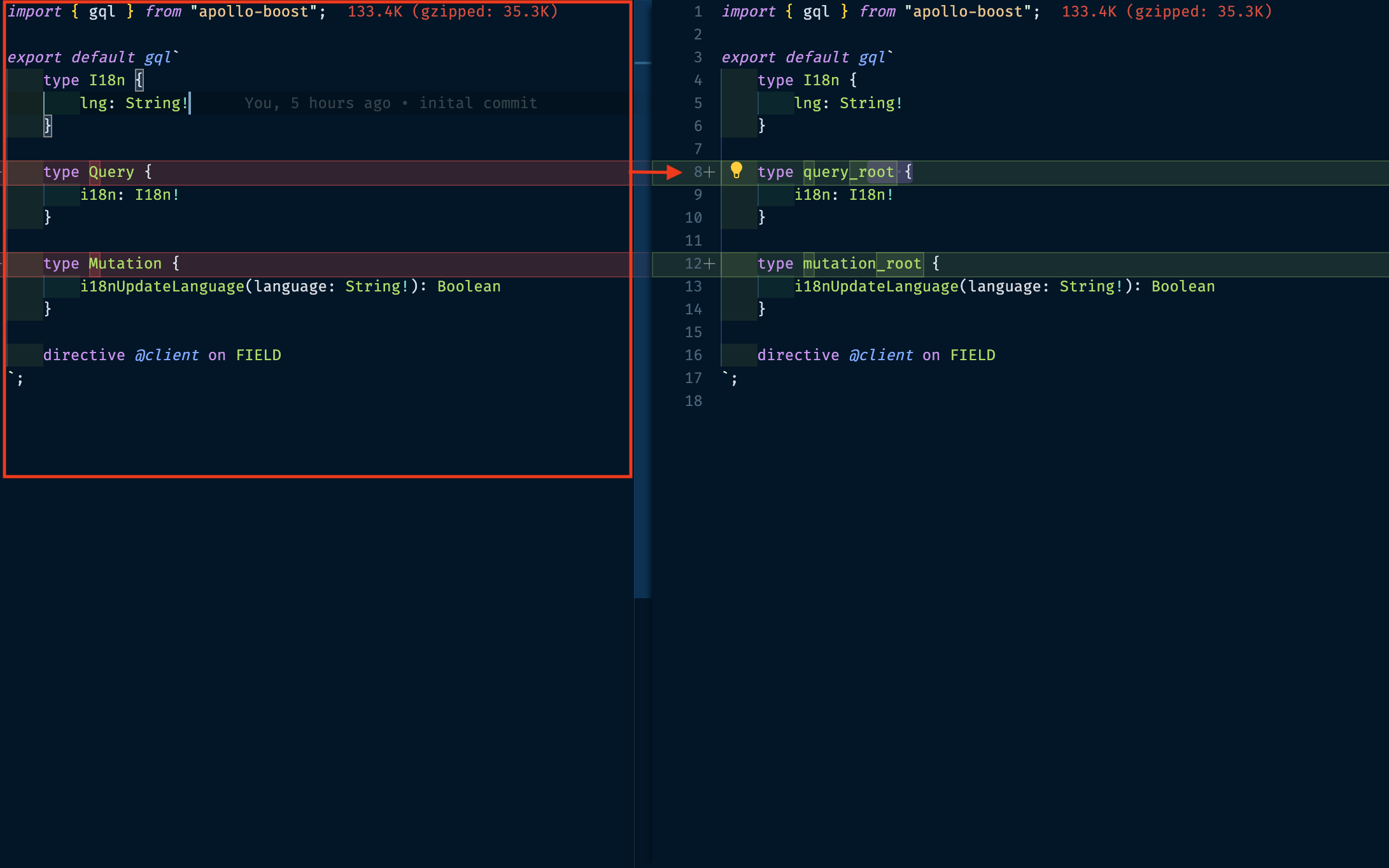A React-typescript configuration template for projects using apollo client as their state management with a connection to a Graphql server.
- React Boilerplate with Typescript and Apollo Client
In order to use this template, you should have a basic understanding of React and Apollo Client.
This boilerplate can be used for three use cases:
- using it with no GraphQL or Hasura API server
- using it with a GraphQL API server
- using it with a Hasura API server
Each of those use cases require some settings before running yarn start. Those settings are shown below:
1. git clone https://github.com/regisBafutwabo/react-typescript-boilerplate.git <YOUR PROJECT NAME>
2. cd <YOUR PROJECT NAME>
3. rm -rf .git : remove the git folder and initiate your own git ...
4. yarn (or npm i )
5. comment or remove the lines in the `.graphqlrc.yml` file located in the root folder as follows(check out the red rectangles):
6. yarn gen (or npm run gen)
7. yarn start (or npm start)
1. git clone https://github.com/regisBafutwabo/react-typescript-boilerplate.git <YOUR PROJECT NAME>
2. cd <YOUR PROJECT NAME>
3. rm -rf .git : remove the git folder and initiate your own git ...
4. yarn (or npm i )
5. setup the .env with the API configurations as shown in the next section
6. yarn gen (or npm run gen)
7. yarn start (or npm start)
1. git clone https://github.com/regisBafutwabo/react-typescript-boilerplate.git <YOUR PROJECT NAME>
2. cd <YOUR PROJECT NAME>
3. rm -rf .git : remove the git folder and initiate your own git ...
4. yarn (or npm i )
5. Modify `src/apollo/state/**/*.schema.ts`: every `*.schema.ts` file in the apollo/state subfolders as follows:
6. yarn gen (or npm run gen)
7. yarn start (or npm start)
By now, I think you have realized that the apollo folder relies on some kind of server link. Here is the way to setup your .env file if you are planning to use it:
-
create the
.envfile in your root folder -
populate in this way (this is an example) :
REACT_APP_GRAPHQL_PROTOCOL = http REACT_APP_GRAPHQL_HOST = localhost REACT_APP_GRAPHQL_PORT = 4000 REACT_APP_GRAPHQL_VERSION = v1 REACT_APP_GRAPHQL_ROUTE = graphql REACT_APP_GRAPHQL_ADMIN_SECRET = 1234
- Typescript - A superset of Javascript providing static typing, classes and interfaces.
- Apollo Client - A fully-featured caching GraphQL client with integrations for React which allows you to easily build UI components that fetch data via GraphQL.Learn More
- Apollo Cache Persist - Utilizes async storage to persist and rehydrate the Apollo store
- React Router DOM - A collection of navigational components that compose declaratively with your application.
- Styled Components - Powerful CSS in JS module providing template literals to support dynamic styling.Learn More
- Ant Design - An enterprise-class UI design language and React UI library with a set of high-quality React components, one of best React UI library for enterprises.Learn More
- EsLint/Prettier/Airbnb linting style - Enforces code styling, and standards. Airbnb's tslint guidelines are followed by default.
- React-i18next - A powerful internationalization framework for React based on i18next.Learn More
- Test - Testing support for React and apollo client.
- Storybook - Enables developers to test UI components in isolation.Learn More
- Server Connection - Used to setup a connection a hasura or GraphQL API server.Learn More on Hasura
This is a setup of the src folder structure:
src/
|── apollo # contains all the apollo client setting and server settings
|── app # contains the Routing of the application
|── assets # contains the images and other medias needed throughout the app
|── components # contains the reusable components (Atomic Design Structure)
|── generated # contains the graphql file generated by graphql-codegen
|── locales # contains every languages that the app will use throughout the app
|── pages # contains all the pages of the app
|── stories # contains all the stories being used in StoryBook
|── styles # contains the custom styles and global styles
|── types # contains all the Typescript declaration files
└── utils # contains all the extra helper function that can be used in the app
This folder is where everything that has to do with apollo and graphql API is setup.
src/apollo/
├── cache # contains the cache setup files
├── middlewares # contains every file that has something to do with the API
└── state # contains every apollo client state(basically the store) and its resolvers and queries
This folder contains our reusable components. It is based on atomic design. There are five distinct levels in atomic design:
Note: In this boiler plate
Pagesis out of the components folder ( My preference 😅)
src/components
├── atoms
├── molecules
├── organisms
└── templates
This folder contains all of the languages that you will be using in your project
src/locales
├── en
│ └── translation.json
└── ko
└── translation.json
Note: You will learn how to extract all of the languages of your app with a script command in the scripts section
this folder contains all of your storybook components. For more information on stroybook and how to create stroies. click here.
start: starts the application
build: generate a production-ready build folder in your root folder
test: run an overall test based on every test file contained in the project
lint: lintify all of the .tsand .tsx files based on our .eslintrc file
gen: generate TypeScript typings out of your GraphQL schema
extract: extracts all the texts that are not in the translation files and add them
storybook: starts the storybook server/app
You are welcome to add a feature or improve this boilerplate since I believe that there is multiple ways to use these tools.
To contribute to <project_name>, follow these steps:
- Fork this repository.
- Create a branch:
git checkout -b <branch_name>. - Make your changes and commit them:
git commit -m '<commit_message>' - Push to the original branch:
git push origin <project_name>/<location> - Create the pull request.
Alternatively see the GitHub documentation on creating a pull request.

